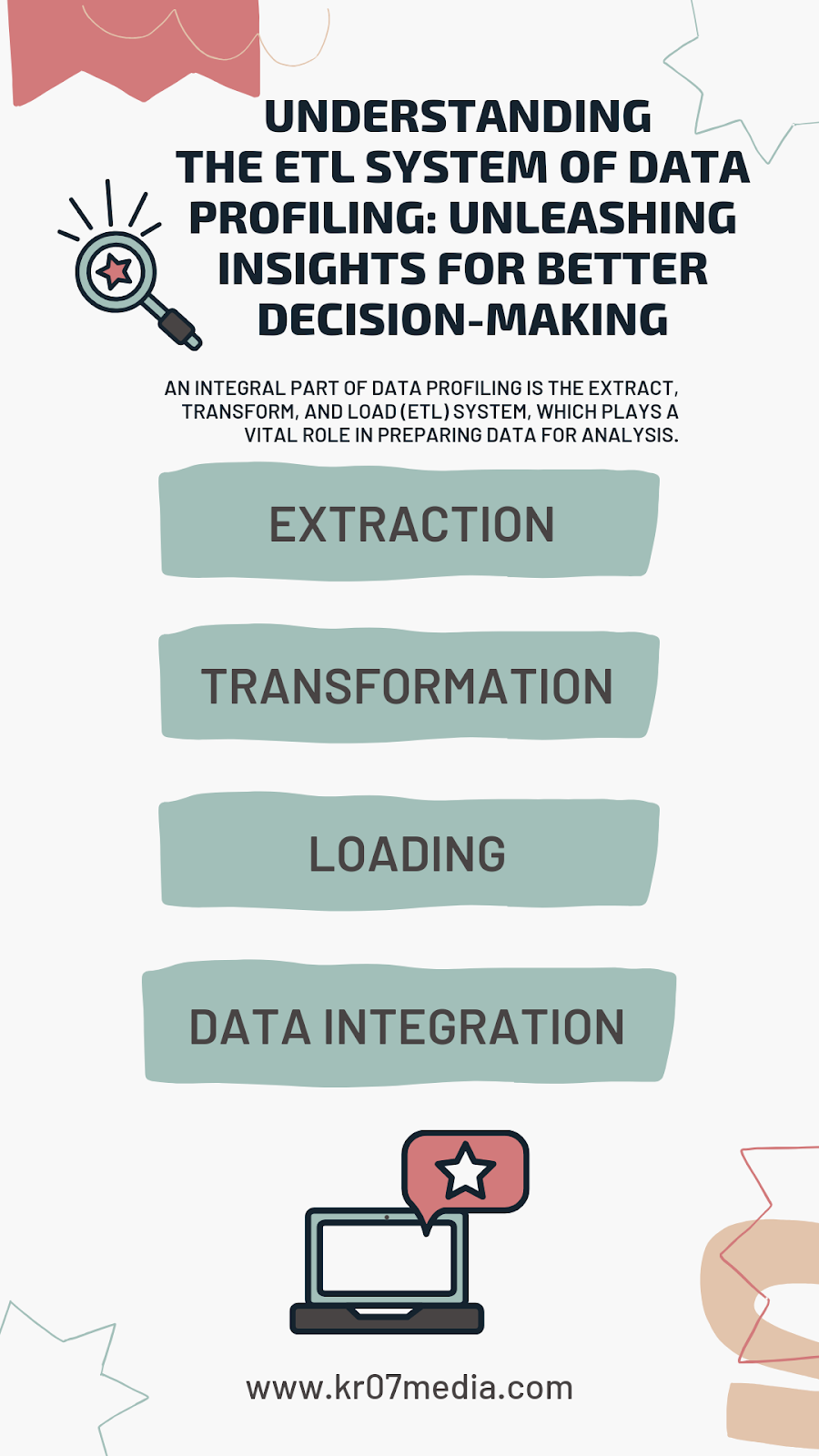Introduction
In today's data-driven world, organizations are inundated with vast amounts of data from various sources. To extract meaningful insights and make informed decisions, businesses rely on the process of data profiling. Data profiling involves analyzing and understanding the characteristics, quality, and structure of data. An integral part of data profiling is the Extract, Transform, and Load (ETL) system, which plays a vital role in preparing data for analysis. In this article, we will explore the ETL system of data profiling and its significance in unraveling valuable insights.
What is Data Profiling?
Data profiling is the process of examining and analyzing data to understand its quality, completeness, and structure. It involves gathering statistical information about data, identifying patterns, and detecting anomalies. The primary goal of data profiling is to gain a comprehensive understanding of the data to ensure its accuracy, relevance, and usability. By profiling data, organizations can assess data quality, identify data issues, and establish data governance practices.
Understanding the ETL System
The ETL system is a critical component of data profiling, facilitating the extraction, transformation, and loading of data into a target system. Let's delve deeper into each stage of the ETL process:
Extraction:
In the extraction phase, data is retrieved from various sources such as databases, files, APIs, or external systems. The data extraction process should ensure data integrity, security, and efficiency. Extraction methods include full extraction, incremental extraction, or real-time extraction, depending on the requirements of the profiling process.
Transformation:
Once the data is extracted, it undergoes a series of transformations to convert it into a usable format. Transformations may include cleaning, standardization, enrichment, aggregation, or consolidation. This stage aims to ensure that the data is consistent, accurate, and aligned with the desired structure and format for analysis.
Loading:
The final stage of the ETL process involves loading the transformed data into a target system, such as a data warehouse, data mart, or analytical database. Loading can be performed in different ways, including batch processing or real-time streaming, depending on the timeliness and frequency of data updates.
Significance of ETL in Data Profiling
The ETL system plays a crucial role in the data profiling process and offers several key benefits:
Data Cleansing:
The transformation phase of ETL enables data cleansing, which involves identifying and rectifying inconsistencies, duplicates, and inaccuracies in the data. By cleansing data, organizations can improve data quality, reduce errors, and enhance the reliability of insights derived from profiling.
Data Integration:
The ETL system allows organizations to integrate data from multiple sources into a centralized repository. This integration facilitates a comprehensive analysis of the entire dataset, enabling organizations to gain holistic insights and identify cross-functional relationships.
Data Standardization:
During the transformation stage, ETL can standardize data by ensuring consistent formats, units, and conventions. Standardization simplifies data comparison and analysis, making it easier to identify patterns, trends, and anomalies.
Scalability and Automation:
The ETL system can handle large volumes of data and automate the profiling process, reducing manual effort and enabling scalability. Automated ETL pipelines ensure consistent and timely profiling, enabling organizations to keep up with the ever-increasing volume and velocity of data.
Conclusion
Data profiling is a critical step in understanding and harnessing the potential of data assets. The ETL system, with its extraction, transformation, and loading capabilities, forms the backbone of data profiling. It facilitates the process of analyzing, cleaning, integrating, and loading data into target systems, ensuring that organizations have accurate, reliable, and actionable insights. By leveraging the power of the ETL system in data profiling, businesses can make informed decisions, drive innovation, and gain a competitive edge in today's data-centric landscape.
In conclusion, understanding the ETL (Extract, Transform, Load) system of data profiling is crucial for unleashing insights that can significantly enhance decision-making processes. ETL, as a fundamental component of data integration, allows organizations to extract data from various sources, transform it into a consistent and usable format, and load it into a target system for analysis and decision-making.
Data profiling, within the context of the ETL system, involves examining and assessing the quality, completeness, and structure of data. It provides valuable insights into the characteristics and patterns of the data, allowing organizations to identify anomalies, inconsistencies, and potential issues. Through data profiling, organizations gain a comprehensive understanding of their data assets, which in turn enables informed decision-making and more accurate analysis.
By utilizing data profiling techniques, organizations can uncover hidden relationships, trends, and patterns within their data. This deeper understanding of data can drive significant improvements in various areas, such as customer segmentation, market analysis, risk assessment, and operational efficiency. Data profiling empowers organizations to make data-driven decisions based on reliable and high-quality information, mitigating the risks associated with poor or inaccurate data.
Moreover, data profiling plays a critical role in data governance and regulatory compliance. It helps organizations ensure data integrity, validate data accuracy, and maintain data consistency across different systems. Through data profiling, organizations can identify and rectify data quality issues, reducing the potential for errors, redundancies, and inconsistencies that may arise from disparate data sources.
In today's data-driven world, the ability to extract meaningful insights from vast amounts of data is a key competitive advantage. The ETL system, coupled with data profiling, equips organizations with the tools and techniques necessary to unleash the full potential of their data assets. It enables decision-makers to make informed and timely choices, driving innovation, efficiency, and growth.
However, it is important to note that understanding the ETL system and implementing effective data profiling strategies require expertise, robust technology infrastructure, and proper governance frameworks. Organizations should invest in skilled data professionals, advanced data integration tools, and establish data management best practices to maximize the benefits of the ETL system and data profiling.
In conclusion, embracing the ETL system of data profiling enables organizations to unlock valuable insights, enabling better decision-making processes. By harnessing the power of data, organizations can gain a competitive edge, optimize operations, and drive sustainable growth in an increasingly data-centric landscape.



